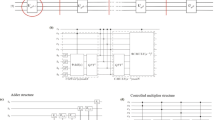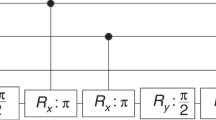Abstract
The algorithms that best demonstrate the potential of quantum computing are Shor’s algorithm and Grover’s algorithm. To this day, new evidence continues to emerge in the form of algorithms or ingenious applications that increase the field of application of this type of computing. However, given the limited number of qubits in current quantum computers, and also the noise problems they currently suffer from, implementing optimized circuits that allow us to take full advantage of the available resources, as well as detecting and correcting the errors caused by this noise, is a priority. In this work we present several leading zero detector circuits for quantum computers and simulators, optimized in terms of noise tolerance and number of qubits. These circuits are a fundamental part in major circuits that perform operations as important and basic in computation as addition and division.











Similar content being viewed by others
Explore related subjects
Discover the latest articles, news and stories from top researchers in related subjects.Data availability
Data sharing is not applicable to this article as no datasets were generated or analysed during the current study.
References
Pérez-Salinas, A., Cervera-Lierta, A., Gil-Fuster, E., Latorre, J.: Data re-uploading for a universal quantum classifier. Quantum 4, 226 (2020)
Orts, F., Ortega, G., Cucura, A., Filatovas, E., Garzón, E.: Optimal fault-tolerant quantum comparators for image binarization. J. Supercomput. 77, 8433–8444 (2021)
Jones, T., Brown, A., Bush, I., Benjamin, S.: Quest and high performance simulation of quantum computers. Sci. Rep. 9(1), 1–11 (2019)
Steiger, D., Häner, T., Troyer, M.: Projectq: an open source software framework for quantum computing. Quantum 2, 49 (2018)
Nielsen, M., Chuang, I.: Quantum Computation and Quantum Information. Cambridge University Press, Cambridge (2002)
Grover, L.: A fast quantum mechanical algorithm for database search. In: Proceedings of the Twenty-Eighth Annual ACM Symposium on Theory of Computing, pp. 212–219 (1996)
Grover, L.: Quantum mechanics helps in searching for a needle in a haystack. Phys. Rev. Lett. 79(2), 325 (1997)
Combarro, E., Ranilla, J., Rúa, I.: Experiments testing the commutativity of finite-dimensional algebras with a quantum adiabatic algorithm. Comput. Math. Methods 1(1), e1009 (2019)
Bernhardt, C.: Quantum Computing for Everyone. MIT Press, Cambridge (2019)
Nguyen, T., Van Meter, R.: A resource-efficient design for a reversible floating point adder in quantum computing. ACM J. Emerg. Technol. Comput. Syst. (JETC) 11(2), 1–18 (2014)
Amy, M., Maslov, D., Mosca, M.: Polynomial-time t-depth optimization of Clifford+ t circuits via matroid partitioning. IEEE Trans. Comput. Aided Des. Integr. Circuits Syst. 33(10), 1476–1489 (2014)
Thapliyal, H., Muñoz-Coreas, E., Khalus, V.: Quantum circuit designs of carry lookahead adder optimized for T-count, T-depth, and qubits. Sustain. Comput. Inf. Syst. 29, 100457 (2021)
Orts, F., Ortega, G., Garzón, E.: Efficient reversible quantum design of sign-magnitude to two’s complement converters. Quantum Inf. Comput. 20(9–10), 747–765 (2020)
Oklobdzija, V.: An algorithmic and novel design of a leading zero detector circuit: comparison with logic synthesis. IEEE Trans. Very Large Scale Integr. VLSI Syst. 2(1), 124–128 (1994)
AnanthaLakshmi, A., Sudha, G.: Design of an efficient reversible single precision floating point adder. Int. J. Comput. Intell. Stud. 4(1), 2–30 (2015)
Gayathri, S., Kumar, R., Dhanalakshmi, S., Dooly, G., Duraibabu, D.: T-count optimized quantum circuit designs for single-precision floating-point division. Electronics 10(6), 703 (2021)
Nguyen, T., Van Meter, R.: A space-efficient design for reversible floating point adder in quantum computing. ACM J. Emerg. Technol. Comput. Syst. (2013). https://doi.org/10.1145/2629525
Nandan, D., Kanungo, J., Mahajan, A.: Implementation of leading one detector based on reversible logic for logarithmic arithmetic. Int. J. Comput. Appl. 173(8), 40–45 (2017)
Li, H.-S., Fan, P., Peng, H., Song, S., Long, G.-L.: Multilevel 2-d quantum wavelet transforms. IEEE Trans. Cybern. 52(8), 8467–848 (2022)
Orts, F., Ortega, G., Combarro, E., Garzón, E.: A review on reversible quantum adders. J. Netw. Comput. Appl. 170, 102810 (2020)
Shor, P.: Polynomial-time algorithms for prime factorization and discrete logarithms on a quantum computer. SIAM Rev. 41(2), 303–332 (1999)
Babbush, R., Gidney, C., Berry, D., Wiebe, N., McClean, J., Paler, A., Fowler, A., Neven, H.: Encoding electronic spectra in quantum circuits with linear t complexity. Phys. Rev. X 8(4), 041015 (2018)
Gidney, C., Ekerå, M.: How to factor 2048 bit RSA integers in 8 hours using 20 million noisy qubits. Quantum 5, 433 (2021)
Bernstein, D., Lange, T., Martindale, C., Panny, L.: Quantum circuits for the CSIDH: optimizing quantum evaluation of isogenies. In: Annual International Conference on the Theory and Applications of Cryptographic Techniques, pp. 409–441. Springer, Berlin (2019)
Sheng-Xing, Z., Gui-Lu, L., Xiao-Shu, L.: A remote quantum adding machine. Chin. Phys. Lett. 19(11), 1579 (2002)
Li, H., Fan, P., Xia, H., Peng, H., Long, G.: Efficient quantum arithmetic operation circuits for quantum image processing. Sci. China Phys. Mech. Astron. 63, 1–13 (2020)
Zhou, R., Hu, W., Fan, P., Ian, H.: Quantum realization of the bilinear interpolation method for NEQR. Sci. Rep. 7(1), 1–17 (2017)
Wei, A., Naik, P., Harrow, A., Thaler, J.: Quantum algorithms for jet clustering. Phys. Rev. D 101(9), 094015 (2020)
Gyongyosi, L., Imre, S.: Quantum circuit design for objective function maximization in gate-model quantum computers. Quantum Inf. Process. 18(7), 1–33 (2019)
Mohammadi, M., Eshghi, M.: On figures of merit in reversible and quantum logic designs. Quantum Inf. Process. 8(4), 297–318 (2009)
Noorallahzadeh, M., Mosleh, M.: Parity-preserving reversible flip-flops with low quantum cost in nanoscale. J. Supercomput. 76(3), 2206–2238 (2020)
Noorallahzadeh, M., Mosleh, M.: Efficient designs of reversible latches with low quantum cost. IET Circuits Devices Syst. 13(6), 806–815 (2019)
Gaur, H., Singh, A., Ghanekar, U.: In-depth comparative analysis of reversible gates for designing logic circuits. Procedia Comput. Sci. 125, 810–817 (2018)
Orts, F., Ortega, G., Garzón, E.: An optimized quantum circuit for converting from sign-magnitude to two’s complement. Quantum Inf. Process. 18(11), 1–14 (2019)
Gidney, C.: Halving the cost of quantum addition. Quantum 2, 74 (2018)
Amy, M., Maslov, D., Mosca, M., Roetteler, M.: A meet-in-the-middle algorithm for fast synthesis of depth-optimal quantum circuits. IEEE Trans. Comput. Aided Des. Integr. Circuits Syst. 32(6), 818–830 (2013)
Jones, C.: Low-overhead constructions for the fault-tolerant Toffoli gate. Phys. Rev. A 87(2), 022328 (2013)
Selinger, P.: Quantum circuits of t-depth one. Phys. Rev. A 87(4), 042302 (2013)
Barenco, A., Bennett, C., Cleve, R., DiVincenzo, D., Margolus, N., Shor, P., Sleator, T., Smolin, J.A., Weinfurter, H.: Elementary gates for quantum computation. Phys. Rev. A 52(5), 3457 (1995)
Liu, Y., Long, G.L., Sun, Y.: Analytic one-bit and CNOT gate constructions of general n-qubit controlled gates. Int. J. Quantum Inf. 6(03), 447–462 (2008)
Amy, M., Ross, N.: The phase/state duality in reversible circuit design, arXiv preprint arXiv:2105.13410
Große, D., Wille, R., Dueck, G., Drechsler, R.: Exact synthesis of elementary quantum gate circuits for reversible functions with don’t cares. In: 38th International Symposium on Multiple Valued Logic (ISMVL 2008), IEEE, pp. 214–219 (2008)
Acknowledgements
This work was supported in part under Grants PID2020-119082RB-C22, PID2021-123461NB-C22, PID2021-123278OB-I00 and MTM-2017-83506-C2-2-P funded by MCIN/AEI/ 10.13039/501100011033; by the Regional Ministry of Junta de Andalucía under the Grants P20_00748, IC-DRUGS-P18-RT-1193, UAL2020-TIC-A2101, and UAL18-TIC-A020-B; by Gobierno del Principado de Asturias under Grant AYUD/2021/50994, and by the European Regional Development Fund (ERDF).
Author information
Authors and Affiliations
Corresponding author
Additional information
Publisher's Note
Springer Nature remains neutral with regard to jurisdictional claims in published maps and institutional affiliations.
Rights and permissions
Springer Nature or its licensor (e.g. a society or other partner) holds exclusive rights to this article under a publishing agreement with the author(s) or other rightsholder(s); author self-archiving of the accepted manuscript version of this article is solely governed by the terms of such publishing agreement and applicable law.
About this article
Cite this article
Orts, F., Ortega, G., Combarro, E.F. et al. Optimized quantum leading zero detector circuits. Quantum Inf Process 22, 28 (2023). https://doi.org/10.1007/s11128-022-03784-3
Received:
Accepted:
Published:
DOI: https://doi.org/10.1007/s11128-022-03784-3




